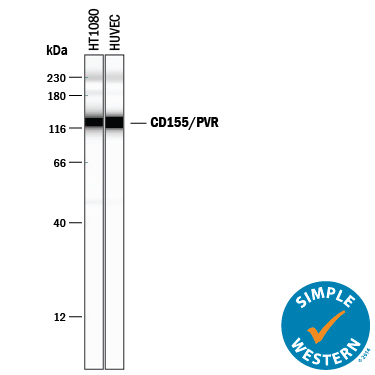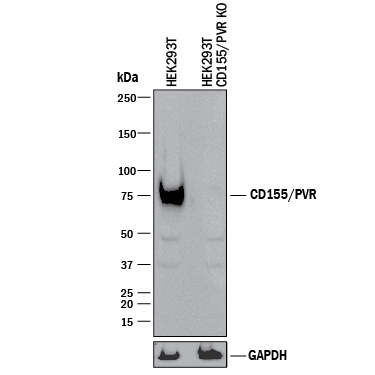Human CD155/PVR Antibody Summary
Gly27-Asn343
Accession # AAH15542
Applications
Please Note: Optimal dilutions should be determined by each laboratory for each application. General Protocols are available in the Technical Information section on our website.
Scientific Data
 View Larger
View Larger
Detection of Human CD155/PVR by Western Blot. Western blot shows lysates of human heart tissue, HT1080 human fibrosarcoma cell line, and HUVEC human umbilical vein endothelial cells. PVDF membrane was probed with 0.25 µg/mL of Goat Anti-Human CD155/PVR Antigen Affinity-purified Polyclonal Antibody (Catalog # AF2530) followed by HRP-conjugated Anti-Goat IgG Secondary Antibody (Catalog # HAF017). A specific band was detected for CD155/PVR at approximately 75 kDa (as indicated). This experiment was conducted under reducing conditions and using Immunoblot Buffer Group 1.
 View Larger
View Larger
CD155/PVR in U937 human histiocytic lymphoma cell line. CD155/PVR was detected in immersion fixed U937 human histiocytic lymphoma cell line using Goat Anti-Human CD155/PVR Antigen Affinity-purified Polyclonal Antibody (Catalog # AF2530) at 15 µg/mL for 3 hours at room temperature. Cells were stained using the NorthernLights™ 557-conjugated Anti-Goat IgG Secondary Antibody (red; Catalog # NL001) and counterstained with DAPI (blue). Specific staining was localized to cytoplasm. View our protocol for Fluorescent ICC Staining of Non-adherent Cells.
 View Larger
View Larger
Detection of Human CD155/PVR by Simple WesternTM. Simple Western lane view shows lysates of HT1080 human fibrosarcoma cell line and HUVEC human umbilical vein endothelial cells, loaded at 0.2 mg/mL. A specific band was detected for CD155/PVR at approximately 128 kDa (as indicated) using 2.5 µg/mL of Goat Anti-Human CD155/PVR Antigen Affinity-purified Polyclonal Antibody (Catalog # AF2530) followed by 1:50 dilution of HRP-conjugated Anti-Goat IgG Secondary Antibody (Catalog # HAF109). This experiment was conducted under reducing conditions and using the 12-230 kDa separation system.
 View Larger
View Larger
Western Blot Shows Human CD155/PVR Specificity by Using Knockout Cell Line. Western blot shows lysates of HEK293T human embryonic kidney parental cell line and CD155/PVR knockout HEK293T cell line (KO). PVDF membrane was probed with 0.25 µg/mL of Goat Anti-Human CD155/PVR Antigen Affinity-purified Polyclonal Antibody (Catalog # AF2530) followed by HRP-conjugated Anti-Goat IgG Secondary Antibody (Catalog # HAF017). A specific band was detected for CD155/PVR at approximately 75 kDa (as indicated) in the parental HEK293T cell line, but is not detectable in knockout HEK293T cell line. GAPDH (Catalog # AF5718) is shown as a loading control. This experiment was conducted under reducing conditions and using Immunoblot Buffer Group 1.
Reconstitution Calculator
Preparation and Storage
- 12 months from date of receipt, -20 to -70 °C as supplied.
- 1 month, 2 to 8 °C under sterile conditions after reconstitution.
- 6 months, -20 to -70 °C under sterile conditions after reconstitution.
Background: CD155/PVR
CD155 [also known as PVR (poliovirus receptor) and Necl-5 (nectin-like molecule-5)] is a 70 kDa type I transmembrane (TM) glycoprotein that is a member of the nectin-like (Necl) family of nectin-related molecules (1). Like nectins, Necl molecules are Ig superfamily members that contain three Ig-like extracellular domains, a TM segment, and a cytoplasmic tail. Unlike nectins, Necl molecules cannot interact with cytoplasmic afadin (1). While Nectins serve as cell adhesion molecules, the actual functions of most Necls are yet-to-be determined. CD155/PVR was originally isolated based on its ability to mediate polio virus attachment to host cells (2, 3). The full-length (or CD155 alpha isoform) is synthesized as a 417 amino acid (aa) precursor that contains a 20 aa signal sequence, a 323 aa extracellular region, a 24 aa TM segment and a 50 aa cytoplasmic tail. The extracellular region contains one N-terminal V-type and two C2-type Ig-like domains (2, 3). The V‑type domain mediates polio virus binding (4). Three other isoforms exist, all of which retain the Ig-like domains. CD155δ is transmembrane with a shortened cytoplasmic tail of 25 aa. CD155 beta (352 aa) and CD155 gamma (344 aa) are 60‑65 kDa soluble forms that show removal of the TM segment and surrounding amino acids (2, 5). The soluble forms will bind the polio virus (due to the presence of the V-type Ig domain) but afford no protection against polio infection because of low circulating levels (5). CD155 has been demonstrated to bind vitronectin, nectin-3, and DNAM-1 (6‑8). DNAM-1 binding promotes monocyte migration and NK cell killing. CD155 is expressed in all normal tissues and is highly expressed in tumor cells of epithelial and neuronal origin.
- Takai, Y. et al. (2003) Cancer Sci. 94:655.
- Mendelsohn, C.L. et al. (1989) Cell 56:855.
- Koike, H. et al. (1990) EMBO J. 9:3217.
- Koike, S. et al. (1991) Proc. Natl. Acad. Sci. USA 88:4104.
- Baury, B. et al. (2003) Biochem. Biophys. Res. Commun. 309:175.
- Mueller, S. and E. Wimmer (2003) J. Biol. Chem. 278:31251.
- Reymond, N. et al. (2004) J. Exp. Med. 199:1331.
- Lange, R. et al. (2001) Virology 285:218.
Product Datasheets
FAQs
No product specific FAQs exist for this product, however you may
View all Antibody FAQsReviews for Human CD155/PVR Antibody
There are currently no reviews for this product. Be the first to review Human CD155/PVR Antibody and earn rewards!
Have you used Human CD155/PVR Antibody?
Submit a review and receive an Amazon gift card.
$25/€18/£15/$25CAN/¥75 Yuan/¥2500 Yen for a review with an image
$10/€7/£6/$10 CAD/¥70 Yuan/¥1110 Yen for a review without an image

